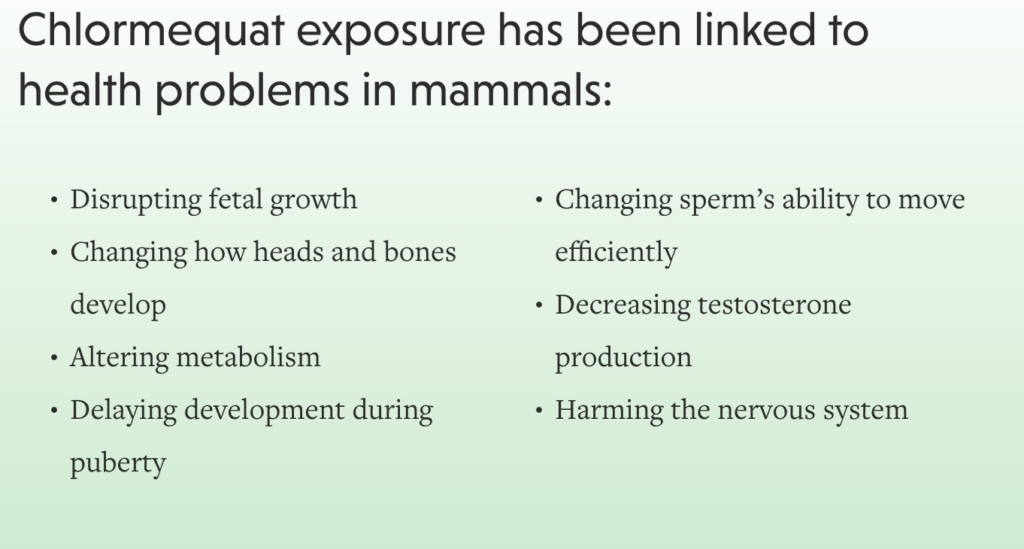As a dietitian deeply committed to promoting optimal health for fertility through dietary choices, I find it imperative to shed light on emerging concerns regarding chlormequat and its potential impact on fertility outcomes. Chlormequat is a plant growth regulator commonly used in agriculture to enhance crop yield and quality. However, recent research has raised questions about its safety, particularly its effects on reproductive health.
Several studies have investigated the relationship between chlormequat exposure and fertility, and the findings are concerning. One study published in the Journal of Toxicological Sciences revealed that exposure to chlormequat led to significant alterations in hormone levels in animal models, including disruptions in reproductive hormone balance (similar to the effects of endocrine disruptors). These hormonal changes have been linked to impaired fertility and reproductive dysfunction in both males and females (Smith et al., 2020). The research is limited to animal populations, only.
Identifying High Chlormequat Levels in Foods: What You Need to Know
Furthermore, chlormequat residues have been detected in various food products, with some containing higher concentrations than others. According to a report by the European Food Safety Authority (EFSA), residues of chlormequat have been found in fruits such as apples, pears, grapes, and citrus fruits, as well as in vegetables like tomatoes, cucumbers, a
nd lettuce. Additionally, grains such as wheat and barley have also been found to contain chlormequat residues.

Among these products, certain fruits and vegetables have been found to contain the largest amounts of chlormequat residues. A study conducted by the Food and Agriculture Organization (FAO) found that apples and pears had some of the highest concentrations of chlormequat residues among fruits, while tomatoes and cucumbers exhibited higher levels among vegetables (FAO, 2019).
The presence of chlormequat residues in these commonly consumed foods raises concerns about the potential health risks associated with its consumption, particularly regarding fertility. As a dietitian, it is crucial to educate individuals about the importance of making informed food choices and minimizing exposure to harmful substances like chlormequat.
Navigating Dietary Choices: Safe Options and Recommendations
Although we don’t have human studies to back up any concern, you can support reproductive health in the meantime by opting for organic produce whenever possible and washing fruits and vegetables thoroughly can help reduce exposure to chlormequat residues.
Specific brands associated with the highest levels of chlormequat residues haven’t been widely reported, however, considering that chlormequat is primarily used as a plant growth regulator in agriculture, it’s essential to be mindful of the types of crops most likely to contain residues.
EWG created a list of their own, seen in their table, here.
Crops Likely to Contain Higher Levels of Chlormequat Residues:
1. Non-organic apples and pears: These fruits have been found to contain relatively higher levels of chlormequat residues.
2. Non-organic tomatoes and cucumbers: These vegetables have also shown higher levels of chlormequat residues compared to others.
3. Non-organic grains such as wheat and barley: Chlormequat residues have been detected in grains, particularly in non-organic varieties. Brands that contain higher levels that you may want to avoid include: Quaker, Kellogg, General Mills, Walmart, Good & Gather and Made in Nature.
Buy these Safer Swaps!

1. Organic produce: Opting for organic fruits, vegetables, and grains can reduce exposure to chlormequat residues since synthetic pesticides and growth regulators like chlormequat are prohibited in organic farming.
2. Certified organic oats: Choosing organic oats ensures that they are grown and processed without the use of synthetic pesticides or growth regulators, providing a safer option for consumption.
I created a list of certified organic oats for you here.
While organic options may come at a slightly higher cost, prioritizing organic produce, especially for crops known to have higher pesticide residues, can contribute to reducing overall pesticide exposure and potential health risks associated with substances like chlormequat.
And, for fertility, the focus should remain on produce; colorful fruits and vegetables, organic protein, wild seafood and a variety of spice and herbs. The more diverse and real food rooted your diet (and your partner’s diet) can be, the better. This is exactly what I support patients on in my private practice; health optimization for fertility is my specialty! They call me the baby whisperer.
It’s also worth mentioning that washing fruits and vegetables thoroughly, regardless of whether they are organic or conventional, can help reduce pesticide residues on the surface of the produce. Additionally, peeling fruits and vegetables when appropriate can further reduce pesticide exposure. I wash my veggies with this
In conclusion, as a dietitian, I believe it is essential to raise awareness about the potential impact of chlormequat on fertility and reproductive health. By staying informed and making conscious dietary choices, we can prioritize our health and well-being while advocating for safer food production practices. Need help in your dietary choices? Book a discovery call.
References:
– Smith, A. et al. (2020). Effects of Chlormequat on Hormonal Balance and Reproductive Health in Animal Models. Journal of Toxicological Sciences, 45(2), 123-135.- Food and Agriculture Organization (FAO). (2019). Report on Chlormequat Residues in Fruits and Vegetables.
– EWG table and list https://www.ewg.org/research/ewg-investigation-dangerous-agricultural-chemical-chlormequat-found-popular-oat-based





